Air Force
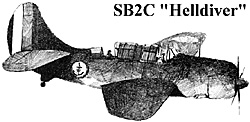 Aeronavale {Naval Air Arm): Navy air operated from two carriers: the Arromanches with 33 F6F "Hellcat" fighters of the 11th Fighter Flotilla, and SB2C "Helidivers" of the 3rd Assault Flotilla; the {formerly U.S.) Belleau Wood 18 F4U "Corsairs" of the 14th Fighter Flotilla replaced the decimated 11th Flotilla over Dien Bien Phu on May 1st. There were also 6 PB4Y2 "Privateers" with the 28th Bomber Flotilla based at Tan Son Nhut.
Aeronavale {Naval Air Arm): Navy air operated from two carriers: the Arromanches with 33 F6F "Hellcat" fighters of the 11th Fighter Flotilla, and SB2C "Helidivers" of the 3rd Assault Flotilla; the {formerly U.S.) Belleau Wood 18 F4U "Corsairs" of the 14th Fighter Flotilla replaced the decimated 11th Flotilla over Dien Bien Phu on May 1st. There were also 6 PB4Y2 "Privateers" with the 28th Bomber Flotilla based at Tan Son Nhut.
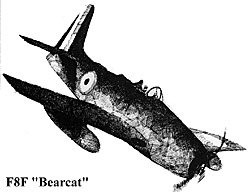 Armee de l'air (AirForce): Two fighter groups (1/22 and 2/22) operated with 79 F8F
"Bearcat" fighter-bombers, and there was also one reconnaissance squadron (80th) which used 18 recce versions of the "Bearcat" 35 A-26 bombers were organized in Bomber Group 1/25, and light scout Morane 500 "Crickets" were used by Aerial Arlillery Observation Groups 21 and 23.
Armee de l'air (AirForce): Two fighter groups (1/22 and 2/22) operated with 79 F8F
"Bearcat" fighter-bombers, and there was also one reconnaissance squadron (80th) which used 18 recce versions of the "Bearcat" 35 A-26 bombers were organized in Bomber Group 1/25, and light scout Morane 500 "Crickets" were used by Aerial Arlillery Observation Groups 21 and 23.
An together, the combined French air over Indochina carried the equivalent bomb tonnage of approximately 10 B-52s. At the height of U.S. bombing against North Vietnam, over 80 B-52s were being used.
French Airlift Units
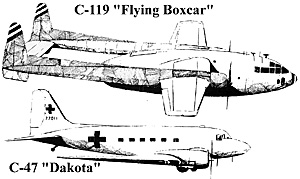 On November 20, 1953, the Armee de l'air d'Indochine had four transport groups, specifically 1/64, 2/64, 1/63, and 2/63. The latter group included five C-119 aircraft piloted by American "volunteers." The remaining 69 transport aircraft were all C-47 types.
On November 20, 1953, the Armee de l'air d'Indochine had four transport groups, specifically 1/64, 2/64, 1/63, and 2/63. The latter group included five C-119 aircraft piloted by American "volunteers." The remaining 69 transport aircraft were all C-47 types.
Up until late 1951 German World War II vintage Ju-52 tri-motor transports had also been used by the French Union Forces in Indochina. One Ju-52 was still on strength with the French Naval Air Arm (Aeronavale), along with two C-47 aircraft.
U.S. M-24 Light Tank
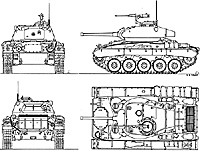
- Combat Weight 20.5 tons
Crew 4 or 5
Road Speed 30 m.p.h.
Range (Radius) 100 miles
Armament: 1 75-mm gun {48 rounds}; 1 .50 cal. machine gun {420 rounds); 1 .30 cal. machine gun (4,125 rounds).
Armor: Hull: 1" Front; Side: 3/4"; Turret: 1.5" front; Side: 1"
Ten M-24 "General Chaffee" tanks made up the Composite Squadron, 1st Regiment of Armored Cavalry, stationed at Dien Bien Phu to provide mobile firepower for the reconnaissance missions and the defense of the perimeter. Although they required reinforced bridges to travel across, the fortress and were a special target of the Communist gunners, the "Bisons"were extremely effective in counterattacks against the Viet-Minh infantry. When immobilized, they functioned as pillboxes. Each tank was identified by a name from French military history which, ironically, in some cases commemorated a battle lost by valiant defenders:
- Auerstadt, Mulhouse, Bazielle, Neumach, Conti, Posen, Dououmont, Ratisbonne, Ettlingen, Smolensk
U.S. 105-mm Howitzer
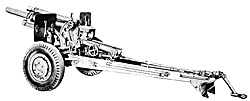 Caliber: 105-mm
Caliber: 105-mm
Weight, traveling position: 4,980 lb.
Standard muzzle velocity (HE) 1,550 f.p.s.
Maximum horizontal range (HE) 12,205 yards
Maximum rate of fire 4 r.pm; 100 r.p.h
The 105-mm howit:er is a highly mobile, general-purpose light field artillery piece. The French 105mm howitzer at Dien Bien Phu were emplaced in shallow circular firing pits, permitting 360-degree traverse, but also exposing the pieces, including their vulnerable hydraulic counter-recoil mechanisms, to shrapnel. The Viet-Minh dug in their 105-mm howitzers so that only the barrel tube was unprotected, but the fixed emplacements limited the sector of fire of the individual howitzer and it could not be trained on other targets without redesigning the bunker and relaying the weapon. The static emplacements facing their targets did allow the Viet-Minh gunners to fire accurately on the French positions, compensating for their lack of fire direction control equipment and simple training.
Soviet M1939 37-mm Antiaircraft Gun
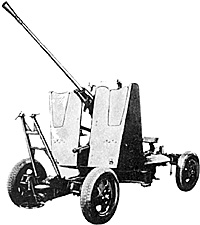 Weight, traveling position 4,620lbs
Weight, traveling position 4,620lbs
Standard muzzle velocity (HE} 2,877 f.p.s.
Range (maximum vertical) 6,540 yards
Range (effective AA) 1500 yards
Rate of Fire 80 r.p.m. {practical)
The M1939 37-mm antiaircraft gun is based on the design of the Swedish Bofors, and an on-carriage fire control allows firing at air and ground targets. Massed batteries of these flak guns eventually denied both the valley of Dien Bien Phu and the Communist supply lines to the French Air Force. Lighter weapons, such as 20-mm antiaircraft guns and MGs, could be hand- carried into positions near the French airfield to supplement the longer-range 37-mm guns which were more permallently emplaced along the heights of the valley.
More Dien Bien Phu
-
Dien Bien Phu: Introduction
Dien Bien Phu: French Arrival: 20 Nov. 1953
Dien Bien Phu: Vietnamese Attack: 13 Mar. 1954
Dien Bien Phu: French Counterattack: 10 Apr. 1954
Dien Bien Phu: Soldiers
Dien Bien Phu: Weaponry
Dien Bien Phu: French Order of Battle
Dien Bien Phu: Viet-Minh Order of Battle
Dien Bien Phu: Map: Last Days May 1-7 (slow: 126K)
Back to Conflict Number 6 Table of Contents
Back to Conflict List of Issues
Back to MagWeb Master Magazine List
© Copyright 1973 by Dana Lombardy
This article appears in MagWeb (Magazine Web) on the Internet World Wide Web.
Other military history articles and gaming articles are available at http://www.magweb.com